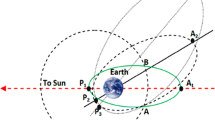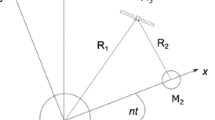Abstract
A maneuver called “Aero-Gravity Assisted” is known in the literature to increase the energy gains given by a close approach between a spacecraft and a planet using the atmosphere of the planet. In a sequence of studies related to this problem, the present paper studies close approaches between a spacecraft and the Earth, in situations where the passage is close enough to the surface of the Earth such that the spacecraft crosses its atmosphere. The dynamical model considers the atmosphere of the Earth, in terms of drag and lift, the gravitational fields of the Earth and the Sun, assumed to be points of mass, and the spacecraft. The Earth and the Sun are assumed to be in circular coplanar orbits around their common center of mass. The equations of motion are the ones given by the circular planar restricted three-body problem with the addition of the forces generated by the atmospheric drag and lift. The primary objective is to map the variations of energy of the orbits of the spacecraft due to this close approach. The results show how the atmosphere affects the trajectory of the spacecraft, generating situations where the variation of energy changes sign with respect to the gravity part of the maneuver or where they have a zero net result, based in the equilibrium between atmospheric and gravity forces. This result opens the possibility of changing only the eccentricity of the orbit, keeping fixed its semi-major axis.











Similar content being viewed by others
References
Armellin R, Lavagna M, Starkey RP, Lewis MJ (2007) Aerogravity-assist maneuvers: coupled trajectory and vehicle shape optimization. J Spacecr Rockets 44(5):1051
Armellin R, Lavagna M, Ercoli-Finzi A (2006) Aero-gravity assist maneuvers: controlled dynamics modeling and optimization. Celest Mech Dyn Astron 95:391–405
Bonfiglio EP, Longuski JM, Vinh NX (2000) Automated design of Aerogravity-assist trajectories. J Spacecr Rockets 37(6):768
Broucke RA (1988) The celestial mechanics of gravity assist. AIAA paper 88–4220. In: AIAA/AAS astrodynamics conference, Minneapolis, MN, 15–17 Aug, 1988
Cardoso G, Souza M (2009) Análise e Simulação de Reentradas Atmosféricas Controladas (in Portuguese). INPE, São José dos Campos
Carvell R (1986) Ulysses—the sun from above and below. Space 1:18–55
D’Amario LA, Byrnes DV, Stanford RH (1982) Interplanetary trajectory optimization with application to Galileo. J Guid Cont Dyn 5(5):465–471
Davies C, Arcadi M (2006) Planetary mission entry vehicles quick reference guide, V3.0, NASA SP 2006–3401
Dunham D, Davis S (1985) Optimization of a multiple lunar- swing-by trajectory sequence. J Astron Sci 33(3):275–288
Elices T (1995) Maximum Delta-V in the aerogravity assist maneuver. J Spacecr Rockets 32(5):921–922
Flandro G (1966) Fast reconnaissance missions to the outer solar system utilizing energy derived from the gravitational field of jupiter. Astr Acta 12:329–337
Gillespie RW, Ross S (1967) Venus-swingby mission mode and its role in the manned exploration of Mars. J Spac Roc 4(2):170
Gomes VM, Prado AFBA (2010) A study of the impact of the initial energy in a close approach of a cloud of particles. WSEAS Trans Math 9:811–820
Gomes VM, Prado AFBA, Golebiewska J (2013) Dynamics of space particles and spacecrafts passing by the atmosphere of the Earth. Sci World J 2013:1–6
Guedes UTV (1997) Análise de dispersão da trajetória de reentrada em relação ao ponto de pouso, utilizando sistema geocêntrico inercial e manobras laterais, in Portuguese. Ph.D Dissertation, Institiuto Nacional de Pesquisas Espaciais, 1997
Helton AF, Strange NJ, Longuski JM (2002) Automated desing of the Europa orbiter tour. J Spac Roc 39(1):17–22
Hollister WM, Menning MD (1970) Periodic swing-by obits between Earth and Venus. J Spac Roc 7(10):1193–1199
Ivanov PB, Papaloizou JCB (2011) Close encounters of a rotating star with planets in parabolic orbits of varying inclination and the formation of hot Jupiters. Celest Mech Dyn Astron 111:51–82
Kawaguchi J, Yamakawa H, Uesugi T, Matsuo H (1995) On making use of lunar and solar gravity assists in LUNAR-A PLANET-b missions. Acta Astron 35(Suppl):633–646
Kuga H, Carrara V, Rao K (2011) Satélites artificiais—movimento orbital (in Portuguese). INPE, São José dos Campos
Laskar J, Marchal C (1984) Triple close approach in the three body problem: a limit for the bounded orbits. Celest Mech 32:15–28
Lavagna M, Povoleri A, Finzi AE (2005) Interplanetary mission design with aero-assisted manoeuvres multi-objective evolutive optimization. Acta Astron 57:498
Lewis MJ, McRonald AD (1992) Design of hypersonic waveridders for aeroassisted interplanetary trajectories. J Spacecr Rockets 29(5):653
Lohar FA (1996) Optimal aero-gravity assist with heliocentric plane change. Acta Astron 38(4–8):445
Lohar FA, Mateescu D, Misra AK (1994) Optimal atmospheric trajectory for aero-gravity-assist. Acta Astrona 32(2):89
Lohar FA, Misra AK, Mateescu D (1997) Mars–jupiter aerogravity assist trajectories for high-energy missions. J Spacecr Rockets 34(1):16
Longuski JM, Williams SN (1995) The last grand tour opportunity to Pluto. J Astron Sci 39(1991):359–365
Marsh SM, Howell KC (1988) Double lunar swing by trajectory design. AIAA paper 88–4289
McConaghy TT, Debban TJ, Petropoulos AE, Longuski JM (2003) Design and optimization of low-thrust gravity trajectories with gravity assist. J Spacecr Rockets 40(3):380–387
McRonald AD, Randolph JE (1992) Hypersonic maneuvering for augmenting planetary gravity assist. J Spacecr Rockets 29(2):216
Minovich MA (1961) A method for determining interplanetary free-fall reconnaissance trajectories. JPL Tech Memo 312–130. Pasadena: JPL
Minzner R, Champion K, Pond H (1959) The ARDC model atmosphere, 1959. Air Force Surveys in Geophysics N115
Montenbruck O, Gill E (2000) Satellite orbits—models, methods, and applications. Springer, Berlin
NASA/NOAA (1976) US standard atmosphere 1976. NASA TM-X74335, Washington DC
Okutsu M, Yam CH, Longuski JM (2006) Low-thrust trajectories to jupiter via gravity assists from Venus, Earth and Mars. AIAA Paper 2006–6745
Prado AFBA (1997) Powered swing-by. J Guid Cont Dyn 19(5):1142–1147
Prado AFBA, Broucke RA (1995) Effects of atmospheric drag in swing-by trajectory. Acta Astron 36(6):285–290
Randolph JE, McRonald AD (1992) Solar system “Fast Mission” trajectories using aerogravity assist. J Spacecr Rockets 29(2):223
Reagan F, Anandakrishnan S (1993) Dynamics of atmospheric re-entry. AIAA, Washington
Schulz W, Prado AFBA, Kuga HK, de Moraes RV (2002) Optimal space manoeuvres in a non-Keplerian force field. Adv Space Res 30(2):345–350
Silva AF, Prado AFBA, Winter OC (2013) Optimal impulsive control in a powered swing-by. In: AIAA guidance, navigation, and control (GNC) conference: Boston. AIAA guidance, navigation, and control (GNC) conference. Reston: American Institute of Aeronautics and Astronautics. vol 1, 2013
Silva AF, Prado AFBA, Winter OC (2013) Powered swing-by maneuvers around the Moon. J Phys Conf Series (Print), vol 465, p 012001, 2013
Silva AF, Prado AFBA, Winter OC (2015) A numerical study of powered swing-bys around the moon. Adv Space Res (to be published)
Sims JA, Longuski JM, Patel MR (1995) Aerogravity-assist trajectories to the outer planets. Acta Astron 35:297
Sims JA, Longuski JM, Patel MR (2000) Aerogravity-assist trajectories to the outer planets and the effect of drag. J Spacecr Rockets 37(1):49
Strange NJ, Longuski JM (2002) Graphical method for gravity-assist trajectory design. J Spacecr Rockets 39(1):9–16
Szebehely V (1973) Triple close approaches is the problem of three bodies. Celest Mech 8:163–167
Szebehely VG (1967) Theory of orbits. Academic, New York
Tewari A (2007) Atmospheric and spaceflight dynamics. Birkhauser, Boston
Titus RR (1965) Powered flyby of Mars. Astron Acta 11(5)
Zipfel P (2007) Modeling and simulation of aerospace vehicle dynamics, 2nd edn. AIAA Education Series 2007
Acknowledgments
The authors wish to express their appreciation for the support provided by Grants #473387/2012-3, 473164/2013-2 and 304700/2009-6 from the National Council for Scientific and Technological Development (CNPq); Grants # 2011/08171-3, 2011/13101-4, 2014/06688-7 and 2012/21023-6 from São Paulo Research Foundation (FAPESP) and the financial support from the National Council for the Improvement of Higher Education (CAPES).
Author information
Authors and Affiliations
Corresponding author
Additional information
Communicated by Elbert E. N. Macau, Antônio Fernando Bertachini de Almeida Prado and Cristiano Fiorilo de Melo.
Rights and permissions
About this article
Cite this article
Gomes, V.M., Piñeros, J.O.M., Prado, A.F.B.d.A. et al. Atmospheric close approaches with the Earth considering drag and lift forces. Comp. Appl. Math. 35, 817–833 (2016). https://doi.org/10.1007/s40314-015-0256-x
Received:
Revised:
Accepted:
Published:
Issue Date:
DOI: https://doi.org/10.1007/s40314-015-0256-x




